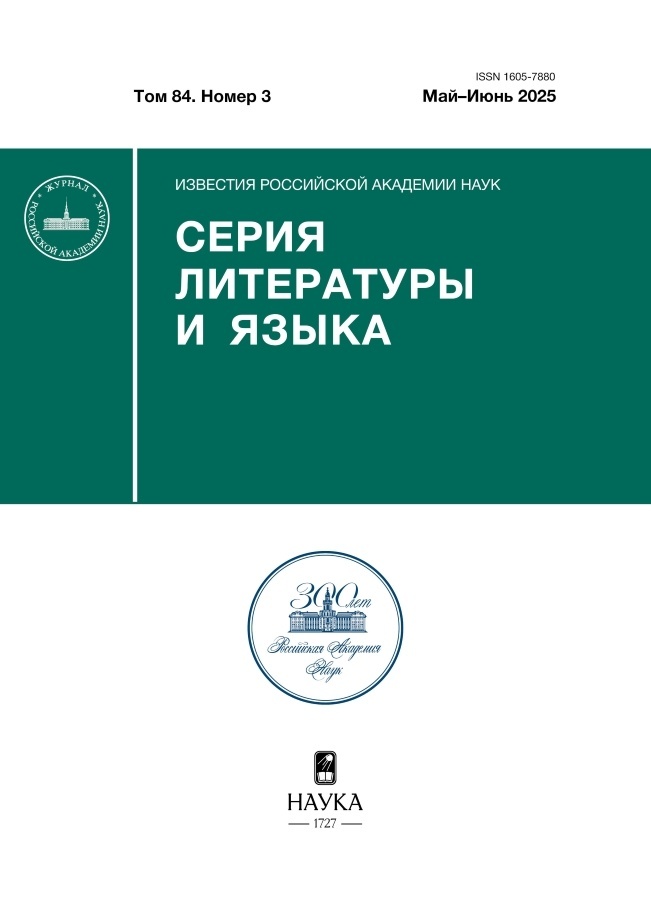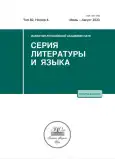Synesthetic Word Combinations in a Parallel Multilingual Corpus
- Authors: Iaroshenko P.V.1
-
Affiliations:
- Institute of Linguistics of the Russian Academy of Sciences
- Issue: Vol 82, No 4 (2023)
- Pages: 91-99
- Section: Articles
- URL: https://vietnamjournal.ru/1605-7880/article/view/656954
- DOI: https://doi.org/10.31857/S160578800027394-9
- ID: 656954
Cite item
Abstract
The article focuses on synesthetic word combinations, defined by the author as a phrase, in which both words have a sensory semantic component and refer to different perceptual modalities (for example, “green echo&8j1; refers to vision and hearing). A parallel multilingual corpus has been designed to become the material for the study. The corpus includes the novel “Lolita&8j1; by V. Nabokov in English – the original language of the novel – (1955), and its translations into Russian (1967) and French (1959, 2001). The study aims to classify sensory lexical units, which form synesthetic word combinations, and to quantify the size of each class presented in the corpus. The study reveals that the frequency, with which semantic components refer to sensory modalities, tend to differ. Another conclusion to be drawn is that a stable collocability between semantic components referring to certain sensory modalities can be observed. Thus, the analysis of synesthetic word combinations shows that the following senses appear to be most frequently manifested in sensory lexical units: vision (35%), touch (29%), hearing (22%). The words with the components of taste (8%) and smell (6%) are the least frequent. As for collocability, in the original text the vision-hearing combination is revealed to be most frequent, while in the translated version most sensory collocations tend to include vision-touch components. Collocations whose components refer to vision-olfaction and olfaction-hearing appeared to be least numerous.
Keywords
About the authors
Polina V. Iaroshenko
Institute of Linguistics of the Russian Academy of Sciences1 Bld. 1 Bolshoy Kislovskiy Lane, Moscow, 125009, Russia
References
- Ullmann S. The Principles of Semantics. Oxford: Basil Blackwell, 1957. 352 p.
- Ricoeur P. La métaphore vive. Paris: Seuil, 1975. 414 p.
- Day S.A. Synaesthetic metaphors. Doctoral dissertation in Linguistics, Purdue University. 1995. URL: http://www.daysyn.com/Day_1995_-_Synaesthetic_metaphors_in_English_-_part_1.pdf
- Yu N. Synesthetic metaphor: A cognitive perspective // Journal of Literary Semantics. 2003. 32 (1). P. 19–34.
- Geary J. I Is an Other: The Secret Life of Metaphor and How It Shapes the Way We See the World. New York: Harper Collins Publishings, 2011. 652 p.
- Zawisławska M., Falkowska M., Ogrodniczuk M. Verbal synaesthesia in the Polish corpus of synaesthetic metaphors // LaMiCuS. 2018. Vol. 2. P. 226–253.
- Varga D., Németh L., Halácsy P., Kornai A., Trón A., Nagy V. Parallel Corpora for Medium Density Languages // Recent Advances in Natural Language Processing IV. Nicolov N., Bontcheva K., Angelova G., Mitkov R. (ed.). Series: Current Issues in Linguistic Theory. Amsterdam: John Benjamins, 2007. P. 247–258.
- Ярошенко П.В. К проблеме лингвистического понимания идеастезии (на материале мультиязычного параллельного корпуса) // Вестник Санкт-Петербургского университета. Язык и литература. 2023. № 1. С. 156–169.
- Lakoff G., Johnson M. Metaphors We Live by. Chicago: The University of Chicago Press, 1980. 242 p.
- Strik Lievers F., Huang Ch. A Lexicon of Perception for the Identification of Synaesthetic Metaphors in Corpora // Proceedings of the Tenth International Conference on Language Resources and Evaluation (LREC’16). N. Calzolari (ed.). Portorož: European Language Resources Association Publ., 2016. P. 2270–2277.
- Jo C. A corpus-based analysis of synesthetic metaphors in Korean // Linguistic Research. 2019. Vol. 36, № 3. P. 459–483.
- Zhao Q., Huang Ch.-R., Ahrens K. Directionality of linguistic synesthesia in Mandarin: A corpus-based study // Lingua. 2019. Vol. 232. P. 1–15.
- Kumcu A. Linguistic Synesthesia in Turkish: A Corpus-based Study of Crossmodal Directionality // Metaphor and Symbol. 2021 Vol. 36, № 4. P. 241–255.
- Апресян Ю.Д. Избранные труды, том II. Интегральное описание языка и системная лексикография. М.: Школа “Языки русской культурыˮ, 1995. 767 с.
- Рябцева Н.К. Ментальная лексика, когнитивная лингвистика и антропоцентричность языка // Труды международного семинара Диалог 2000 по компьютерной лингвистике и её приложениям. Т. 1. Теоретические проблемы. А.С. Нариньяни (ред.). 2000. URL: https://www.dialog-21.ru/en/digest/2000/articles/ryabtseva/
- Падучева Е.В. Динамические модели в семантике лексики. М.: Языки славянской культуры, 2004. 608 с.
- Кобозева И.М. Свет, звук и запах в их языковой интерпретации (по данным русских глаголов эмиссии) // Проблемы интерпретационной лингвистики: типы восприятия и их языковое воплощение. Новосибирск: НГПУ, 2013. С. 5–28.
- Viberg Å. The verbs of perception: a typological study // Linguistics. 1983. Vol. 21 (1). P. 123–162.
- Viberg Å. Sensation, perception and cognition: Swedish in a typological-contrastive perspective // Functions of Language. 2015. Vol. 22 (1). P. 96–131.
- Winter B. Sensory Linguistics: Language, perception and metaphor. Amsterdam: John Benjamins, 2019. 305 p.
- Ярошенко П.В. Сенсорный семантический компонент как основа для формирования синестезии в тексте (на материале стихотворения А. Рембо Пьяный корабль и его русских переводов) // Вестник Новосибирского государственного университета. Серия: Лингвистика и межкультурная коммуникация. 2020. Т. 18. № 1. С. 144–156.
- Dennett D.C. Intuition pumps and other tools for thinking. London: Penguin Books, 2013. 512 p.
- Macpherson F. The senses: Classic and contemporary philosophical perspectives. Oxford: Oxford University Press, 2011. 432 p.
- Разлогова Е.Э. Стандартные и нестандартные варианты перевода // Вопросы языкознания. 2017. № 4. С. 52-73.
- Day S.A. Synaesthesia and Synaesthetic Metaphors // Psyche. – 1996. – Vol. 2. – P. 2–32.
- Strik Lievers F. Synaestesia: A corpus-based study of cross-modal directionality // Functions of language. 2015. № 22. С. 69–94.
- Рахилина Е.В., Плунгян В.А. О лексико-семантической типологии // Т.А. Майсак, Е.В. Рахилина (ред.). Глаголы движения в воде: лексическая типология. М.: Индрик, 2007. С. 9–26.
- Рахилина Е.В., Резникова Т.И. Фреймовый подход к лексической типологии // Вопросы языкознания. 2013. № 2. С. 3–31.
Supplementary files








